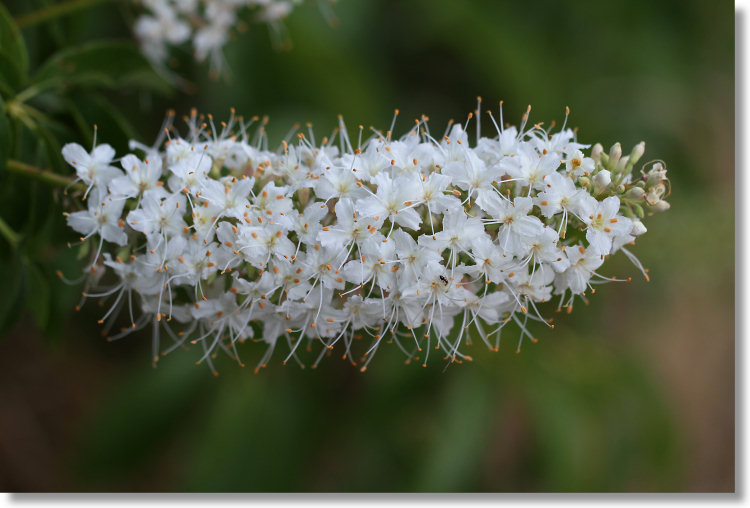
California Buckeye (Aesculus californica)
Aliases: Horse Chestnut
Family: Buckeye (Hippocastanaceae)
California Buckeye is among the most stupendously productive flowering plants in the Yosemite area, with 80 or so blooms on each flower cluster and a single tree easily producing thousands of blossoms. During the peak flowering season in May, I've counted more than 200 buckeye trees blooming at once along Highway 41 between Fresno and the 4,000-foot elevation marker, which means you could pass a million or so buckeye flowers if you take that route to Yosemite.
Although it's especially widespread along Highway 41, you can also see California Buckeye elsewhere in the foothills and above, with a range extending into the lower reaches of Yosemite along Highway 140. CalFlora claims an elevation range extending to nearly 6,000 feet, but the sweet spot seems to be from roughly 1,500 to 3,500 feet.
The discovery of a buckeye in full bloom must be a gratifying event for a questing insect, a sort of locked-in-the-chocolate-factory moment that it will never forget, even if it lives to be a hundred days old. But there's a catch: buckeye nectar contains alkaloids that are toxic to non-native species, notably honeybees. A local beekeeper has told me a mournful tale of his hive acquiring a creeping malaise and eventually dying out after the worker bees began bringing buckeye back home. Some local beekeepers, it turns out, pack up their hives and truck them down to the Central Valley once the buckeyes start blooming in the foothills. [1] [2]
Though they're at their most striking during the bloom period, California Buckeyes are also easily recognizable in the fall, when the otherwise bare branches are covered with the plant's pear-like fruits. The fruits, along with the pollen, nectar, leaves, and shoots, are poisonous - in fact, Native Americans ground the nuts into powder and poured it into streams to stupefy fish. [1] [2] [3]
Blooms: May - June
Lifespan: Perennial (tree or shrub)
Origins: Endemic to California (see distribution map)
Aesculus californica etymology: Aesculus is very similar to the Latin word for "oak" - which, let me hasten to say, California Buckeye is not. Wikipedia claims that Carl Linnaeus named the genus not for the oak itself but for the Latin term for an edible acorn, though I haven't found such a word in any of the Latin dictionaries I've consulted, and in any case, this particular Aesculus doesn't have edible acorns. [1] [2]
Californica is a more tractable problem - it refers to the state of California, where Aesculus californica is endemic. The name for California itself comes from Las Sergas de Esplandián, a 16th-century Spanish romance novel by Garci Rodríguez de Montalvo. In Montalvo's story, California is an island, somewhere east of Asia, inhabited by a female tribe of gold-clad pagan warriors with trained attack griffins. Califia, queen of the Californians, sails them off to Constantinople to join a religious war between Christians and Muslims, where the griffins cause excitement by indiscriminately killing male soldiers from armies on both sides of the conflict. Califia, and by extension California as well, were probably derivations of caliph, a word of Arabic origin indicating a head of state. [1] [2] [3]
This Photo: Along Highway 41 north of Oakhurst, mid June
Other Resources: CalFlora · CalPhotos · USDA